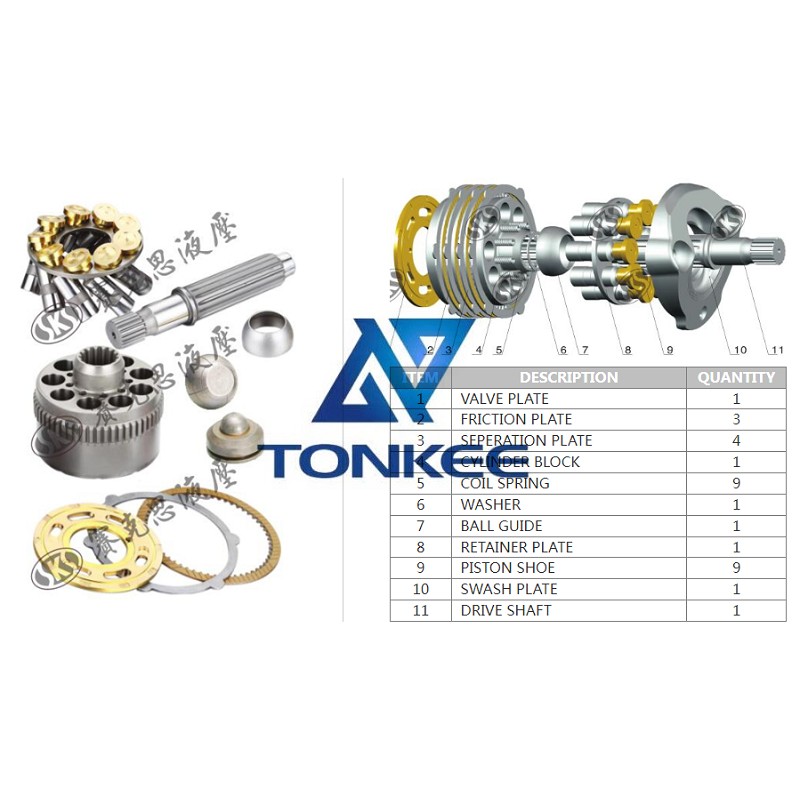
With a knowledge cutoff in September 2021, I do not have specific information on the SK250-8 DRIVE SHAFT hydraulic pump by Partsdic® as it may be a product introduced after my training.
Therefore, I cannot provide an accurate specification for this particular hydraulic pump. However, I can provide a general overview of hydraulic pumps and their functions.
Hydraulic pumps are devices that convert mechanical power into hydraulic energy by pressurizing hydraulic fluid. They are commonly used in hydraulic systems to generate the force required for the movement of actuators, such as hydraulic cylinders or hydraulic motors.
The primary purpose of a hydraulic pump is to provide a steady flow of hydraulic fluid at a specific pressure to drive various hydraulic components within a system. The hydraulic fluid, typically oil, is drawn from a reservoir and then pressurized by the pump. This pressurized fluid is then delivered to the hydraulic system, enabling it to perform various tasks, such as lifting heavy loads, operating steering mechanisms, or powering hydraulic motors.
Hydraulic pumps can be categorized into different types based on their operational principles, including gear pumps, vane pumps, piston pumps, and others. Each type has its unique characteristics, advantages, and limitations, which determine its suitability for specific applications.
In terms of specifications, hydraulic pumps are rated based on various factors such as displacement, pressure rating, flow rate, efficiency, and physical dimensions. The displacement indicates the volume of fluid a pump can deliver per revolution or stroke, usually measured in cubic inches or milliliters. Pressure rating refers to the maximum pressure the pump can generate to provide sufficient force for the hydraulic system. Flow rate represents the volume of fluid delivered by the pump over a specific period, typically measured in gallons per minute or liters per minute.
Efficiency is an essential consideration as it determines how effectively the pump can convert mechanical power into hydraulic energy. Higher efficiency means less power loss and better overall system performance. Physical dimensions, such as the pump's size, weight, and mounting configuration, also play a role in determining its compatibility with the equipment.
When selecting a hydraulic pump, it is crucial to consider the specific requirements of the system, including the desired pressure, flow rate, and operational conditions. It is recommended to consult the manufacturer's specifications or seek expert advice to ensure the compatibility and optimal performance of the hydraulic pump within the intended application.
With a knowledge cutoff in September 2021, I do not have specific information on the SK250-8 DRIVE SHAFT hydraulic pump by Partsdic® as it may be a product introduced after my training. Therefore, I cannot provide an accurate specification for this particular hydraulic pump. However, I can provide a general overview of hydraulic pumps and their functions.
Hydraulic pumps are devices that convert mechanical power into hydraulic energy by pressurizing hydraulic fluid. They are commonly used in hydraulic systems to generate the force required for the movement of actuators, such as hydraulic cylinders or hydraulic motors.
The primary purpose of a hydraulic pump is to provide a steady flow of hydraulic fluid at a specific pressure to drive various hydraulic components within a system. The hydraulic fluid, typically oil, is drawn from a reservoir and then pressurized by the pump. This pressurized fluid is then delivered to the hydraulic system, enabling it to perform various tasks, such as lifting heavy loads, operating steering mechanisms, or powering hydraulic motors.
Hydraulic pumps can be categorized into different types based on their operational principles, including gear pumps, vane pumps, piston pumps, and others. Each type has its unique characteristics, advantages, and limitations, which determine its suitability for specific applications.
In terms of specifications, hydraulic pumps are rated based on various factors such as displacement, pressure rating, flow rate, efficiency, and physical dimensions.
The displacement indicates the volume of fluid a pump can deliver per revolution or stroke, usually measured in cubic inches or milliliters. Pressure rating refers to the maximum pressure the pump can generate to provide sufficient force for the hydraulic system. Flow rate represents the volume of fluid delivered by the pump over a specific period, typically measured in gallons per minute or liters per minute.
Efficiency is an essential consideration as it determines how effectively the pump can convert mechanical power into hydraulic energy. Higher efficiency means less power loss and better overall system performance. Physical dimensions, such as the pump's size, weight, and mounting configuration, also play a role in determining its compatibility with the equipment.
When selecting a hydraulic pump, it is crucial to consider the specific requirements of the system, including the desired pressure, flow rate, and operational conditions. It is recommended to consult the manufacturer's specifications or seek expert advice to ensure the compatibility and optimal performance of the hydraulic pump within the intended application.



 English
English Türkçe
Türkçe


